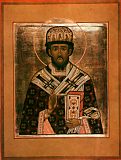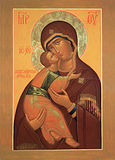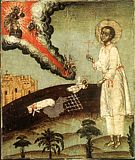 Meeting of the Vladimir Icon of the Most Holy Theotokos (1480).
Meeting of the Vladimir Icon of the Most Holy Theotokos (1480).  Martyr Agrippina of Rome and her companions Paula, Bassa, and Agathonica (253-259).
Martyr Agrippina of Rome and her companions Paula, Bassa, and Agathonica (253-259).  Synaxis of the Saints of Vladimir.
Synaxis of the Saints of Vladimir.
Martyrs Eustochius, Gaius, Proba, Lollia, and Urban, of Ancyra (4th c.). Second translation of the relics of St. Herman, archbishop of Kazan (1714). St. Artemius of Verkola (1545). Translation of the relics of St. Michael of Klops Monastery (Novgorod), fool-for-Christ (1482). St. Dionysius of Polotsk (1182). Sts. Joseph, founder (1612), Anthony, and Ioannicius, abbots, of Zaonikiev Monastery, Vologda (17th c.).
New Hieromartyrs Mitrophan (Krasnopolsky), archbishop of Astrakhan (1919), and Leontius (von Vimpfen), bishop of Enotaeva (1919).
Icons of the Most Holy Theotokos: “Umileniye” (“Of Tender Feeling”) of Pskov (1524), and “Zaonikiev.” (1588)
St. Etheldreda, foundress of Ely Monastery (England) (679). St. Nicetas of Thebes in Boetia and his disciples Theodore, Gregory, and Daniel (1079). Hieromartyrs Aristocleus, priest, Demetrian, deacon, and Athanasius, reader, at Salamis on Cyprus (306).
Repose of Schemamonk Zosimas of Solovki (1855) and Ivan M. Kontzevitch, spiritual writer (1965).
Thursday. [Rom. 15:17-29; Matt. 12:46-13:3]
For whosoever shall do the will of
My Father which is in Heaven, the same is My brother, and
sister, and mother. By this the Lord gives us to know
that the spiritual kinship which He came to plant and
raise up on the earth is not the same as fleshly kinship;
although in the form of its relationships, the spiritual
is the same as the fleshly. The spiritual also contains
fathers and mothers—they are those who give birth to
people with the word of truth or the gospel, as the
apostle Paul says. And it contains also brothers and
sisters—they are those who are born spiritually from
one person and grow in one spirit. The connection between
[spiritual] relatives is founded on the action of grace.
It is not external, not superficial, but as deep and alive
as the fleshly connection, only it has its place in
another much higher and important sphere. This is why it
predominates over the fleshly, and when necessary, it
brings the fleshly as a sacrifice to its spiritual
interests without regret, in full certainty that this
sacrifice is pleasing to God and is required by
Him.
Friday. [Rom. 16:1-16; Matt. 13:4-9]
The parable about the sower depicts
various relationships of souls toward the word of God. In
the first group stand those who do not heed the word at
all. They hear, but what is heard does not enter into
their soul; it lies on its surface, like the seed by the
wayside. The word does not fit in them because they have
another way of thinking, other principles, other tastes.
That is why it soon disappears from memory, is forgotten
as if it was not heard at all. The second group is of
those who hear the word willingly and receive it quickly,
but do not want to bear any labour to fulfil it.
Therefore, they delight in the word—especially its
promises—until a sacrifice is required. As soon as
the necessity arises to sacrifice something for
faithfulness to the word, they betray it, renouncing both
the word and its promises in order to cater to their
attachments. The third group is of those who receive the
word and begin to live according to it, but then give
themselves over to many cares and sorrows of the world, to
earthly concerns, which suppress all the good undertakings
which had just formed under the influence of the word of
God. The fourth group is of those who receive the word
with full faith and resolve to live according to its
requirements, with a readiness for all sacrifices and
labour, and do not allow their heart to be tied to
anything earthly. Sit and decide each of you, to which of
these groups you belong.


![]() Meeting of the Vladimir Icon of the Most Holy Theotokos (1480).
Meeting of the Vladimir Icon of the Most Holy Theotokos (1480). ![]() Martyr Agrippina of Rome and her companions Paula, Bassa, and Agathonica (253-259).
Martyr Agrippina of Rome and her companions Paula, Bassa, and Agathonica (253-259). ![]() Synaxis of the Saints of Vladimir.
Synaxis of the Saints of Vladimir. 

















